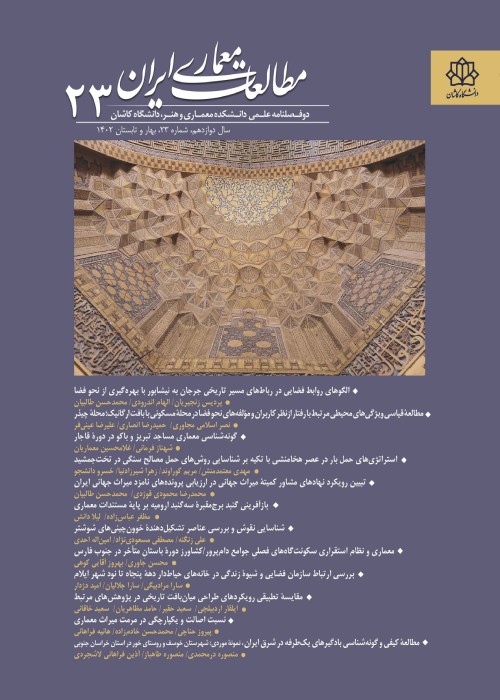Study of the Framework and Strategies for Conservation of Naraq Historic Bazaar and the Surrounding Urban Area
Author(s):
Abstract:
Naraq, which for a long time has been on an important historic route, has been a settlement with a suitable natural environment and adequate water. So, for a long period of time, the city has enjoyed significant agricultural incomes and regional trade revenues. The city's economy was affected and weakened by the consequences of a change in regional routes that its range has expanded to Bazaar. The city has stayed away from the main regional routes and it has led Bazaar to lose its regional and urban status. This problem and the expansion of the city resulting from the construction of a new avenue and a new town have led to an isolation that has involved Bazaar as other parts of the historic city. The construction of the avenue, in addition to the changes caused by the direct destruction of parts of Bazaar and its urban area, has led to the transfer of activities and trades from within the market and the neighborhoods, making the avenue a powerful rival to Bazaar. Therefore, the city that has lost its rich economy, in addition to the destruction of some parts, It also has faced the new element of the avenue, which is the main rival of the market from both commercial and access points, and imposed its requirements to the historic city, including the fact that passage of Bazaar is marginalized and a new business axis and market is formed along the avenue. Nevertheless, Bazaar still has significant values and the historic city needs preservation. This paper, which its methodology is historical-interpretive and it is based on SWOT technique, seeks to answer these questions: What are the challenges of the Naraq historic Bazaar in terms of criteria for the conservation of historic cities? And what can be the strategies for conservation of the Bazaar in the historical context and its sub-divisions? The purpose of this paper is to define a framework and strategies for preserving the Naraq historic Bazaar. The findings of this paper show that any strategy for conservation of the Bazaar should be designed according to its urban context and in relation to the most important elements of the new city, such as avenue and square. In addition, enhancement of Bazaar requires strategies such as revitalization of Bazaar’s complexes, defining and strengthening its commercial centralization, redefining the relation between the Bazaar and the avenue, and strengthening the link between passage of Bazaar and the square.
Keywords:
Language:
Persian
Published:
Journal of Iranian Architecture Studies, Volume:7 Issue: 14, 2019
Pages:
47 to 77
magiran.com/p1953059
دانلود و مطالعه متن این مقاله با یکی از روشهای زیر امکان پذیر است:
اشتراک شخصی
با عضویت و پرداخت آنلاین حق اشتراک یکساله به مبلغ 1,390,000ريال میتوانید 70 عنوان مطلب دانلود کنید!
اشتراک سازمانی
به کتابخانه دانشگاه یا محل کار خود پیشنهاد کنید تا اشتراک سازمانی این پایگاه را برای دسترسی نامحدود همه کاربران به متن مطالب تهیه نمایند!
توجه!
- حق عضویت دریافتی صرف حمایت از نشریات عضو و نگهداری، تکمیل و توسعه مگیران میشود.
- پرداخت حق اشتراک و دانلود مقالات اجازه بازنشر آن در سایر رسانههای چاپی و دیجیتال را به کاربر نمیدهد.
In order to view content subscription is required
Personal subscription
Subscribe magiran.com for 70 € euros via PayPal and download 70 articles during a year.
Organization subscription
Please contact us to subscribe your university or library for unlimited access!




